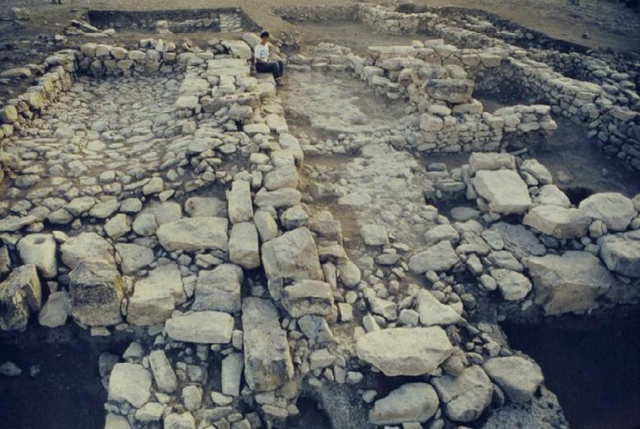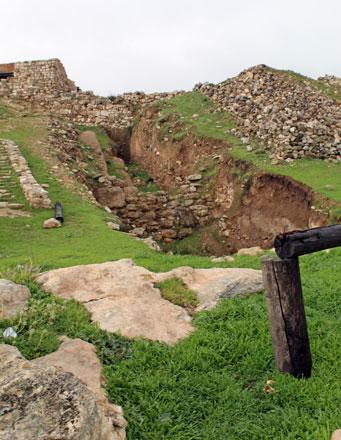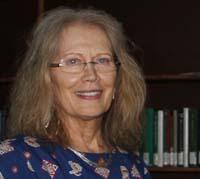You are here
Khirbat Iskander: Focusing on transformations during Early Bronze Age of Jordan
By Saeb Rawashdeh - Feb 26,2024 - Last updated at Feb 26,2024

Excavated remains of the Area C monumental ‘gateway’ at Khirbat Iskander. (Photo courtesy Khirbat Iskander Expedition)
AMMAN — The Early Bronze IV (c. 2,500- 2,000BC) in the ancient Near East was marked by a systematic change. The change manifested itself with the depopulation of bigger urban centres which was called a “collapse”.
However, the transformation was not caused by the dramatic climate change and disruption of agricultural production as some scholars claimed in the past. It was rather a shift in the location of sheep greasing to the liminal zones at the edges of dry-farming, in agriculture from centralised locations around tells to a more ruralised, village-based system, and a shift north of olive and grape production, which went from the southern to the northern Levant.
To get a better perspective of the change, data was extracted from satellite imagery and environmental models to determine agricultural and pastoral zones as well as settlement patterns at the local level, said an American archaeologist, Amy Karoll, noting that the results illustrate that populations during the EB II-III became so entrenched in their previous modes of living, overexploiting the landscape and available resources, that it was no longer sustainable and communities moved into different environmental niches to survive.
Another American archaeologist, Suzanne Richard, also put forth a socioeconomic model to explain changes in social structures during the Early Bronze IV; in this case, based upon her excavations of the site of Khirbet Iskander in the Madaba Plain.
“It was one of the few truly ‘urban’ EB IV sites, completed with a large city wall and possibly even a gateway, and Richard hypothesises that the pastoral nomad model espoused by Dever obscures the complexities inherent in EB VI social groups and instead concludes that the EB IV was composed of ‘loosely integrated society’ comprising a large pastoral element, small agricultural communities and a few regional centres that reflect an adaptation to a level of political autonomy, probably best explained by the chiefdom model,” Karoll elaborated.
Richard later went on to further distinguish this explanation by stressing the exchange between agriculturalists and pastoralists, especially their abilities to maintain specialisation. In times of stress, fewer individuals would specialise in a mode of production and adaptive strategies become more varied in response to these conditions.
“Another socioeconomic exploration of the EB IV was done by Gaetano Palumbo who attempted an ambitious synthesis of the EB IV, proposing that a more ruralised population was dominant in addition to highly regional adaptations,” Karoll said, adding that according to Palumbo enduring groups, including pastoral nomads, semi-nomads, peasants and urban dwellers, were excluded from the previous system centred on tells but their interrelationships were intensified.
The urban component, therefore, does not disappear, but it was rather ruralised and the production sphere was taken out of an urban setting and was instead placed in smaller productive units like farms or hamlets, with production-oriented more along the lines of pastoralism with some agricultural activity to supplement the pastoral component, Karoll underlined, adding that Stephen Falconer proposed an explanation on ruralisation.
“Falconer hypothesised that changes within a given social construct were not necessarily ‘progressions’ as it was previously thought, simply shifts in societal makeup. Bronze Age societies saw intermittent changes in social structure, with the foundation and then abandonment of large fortified towns and various levels of stratified settlement hierarchies,” Karoll underlined.
Much of this explanation started with Falconer’s study of Tell Al Hayyat in the Jordan River Valley in modern Jordan as Tell Al Hayyat had occupations at the beginning in the EB IV and continuing into the MB II.
Based on ceramic and artifactual evidence, some interaction between the inhabitants in this region occurred but with a degree of ruralisation, Karoll stressed, adding that production and consumption were aimed at long-term continuity rather than at short-term economics.
Excavations at EB IV rural settlements throughout the Levant show that sedentary populations continued to exist despite the abandonment of the cities.
According to Karoll, Raphael Greenberg attempts a new perspective on the sociopolitical atmosphere of the Bronze Age as a whole putting forth an explanation centred on the de-centralisation of cities and the economy while addressing regionalism and local settlement trajectories that were different across the Levant.
“Various approaches to the EB IV have been made over the years and each hypothesis attempts to explain what happened during this period from different points of view, whether they focused on invasion of foreign people groups, regionalism as highlighted by stylistics and artifactual change, or socioeconomic models of change,” Karoll highlighted, adding that the EB IV was a difficult period to characterise.
Related Articles
AMMAN — The system of centralised, urbanised settlements established in agriculturally productive valleys and plans broke down in the southe
AMMAN — Bayesian modelling, a method of statistical analysis, applied to Radiocarbon dating, has changed perceptions of the Early Bronze Age
AMMAN — For decades, many scholars have attempted to connect the Bronze Age with urbanism in the Levant and some of the archaeologists and h



















